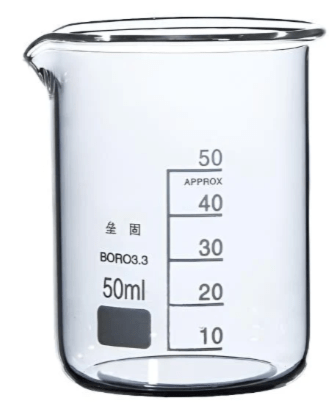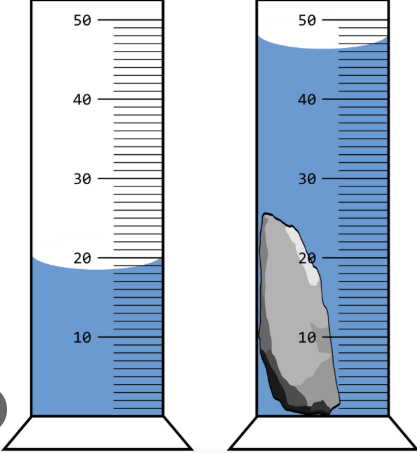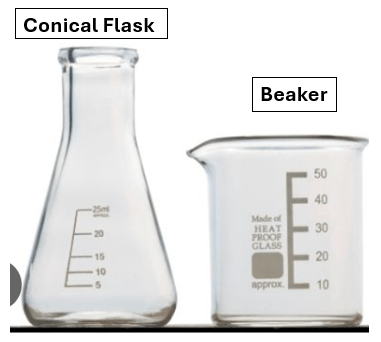Name two pieces of safety equipment found in most science labs?
Any 2 -
Safety glasses
Lab coats
Gloves
Fire blanket
Fire extinguisher
Emergency stop button
Spill kit
 What is a Beaker used for?
What is a Beaker used for?
Holding, mixing, or heating liquids.
What words does the aim in an experiment start with?
To observe/investigate/test...
Name and draw the particle arrangement of the three main states of matter.

What is density and what unit is density usually measured in?
The amount of mass per unit of volume (mass ÷ volume).
How heavy something is for it's size.
g/cm³ or kg/m³
Why is it important to tie hair back during a practical?
Any of the following. Prevents potential hazards like -
Catching on fire
Contamination with chemicals or specimens,
Getting caught in equipment.
If a student wanted to measure the temperature, what piece of equipment would they use?
Thermometer
Define the term “independent variable.”
The variable that is changed on purpose in an experiment.
What happens to particles in a substance when it is heated?
They gain energy and move faster.
If a block has a mass of 20g and a volume of 4cm³, what is its density?
5g/cm³
What does the emergency stop button in a lab control? Give an example of when would you use it?
It cuts off gas and electricity.
You would use it during a dangerous situation like a fire or electric hazard.
 Are scientific diagrams of an experimental set-up are drawn in 2D or 3D?
Are scientific diagrams of an experimental set-up are drawn in 2D or 3D?
2D!
What does a hypothesis include?
A prediction about the results
A clear testable relationship between the independent and dependent variable.
What 3 things does the particle model state?
All matter is composed of tiny, indivisible particles (atoms)
Particles are in constant motion
These particles are attracted to each other.
Water has a density of 1g/cm³. Will an object with a density of 0.8g/cm³ float or sink in water? Why?
Float, because its density is less than water.
Why is it important to know the location of the fire blanket and safety shower?
To quickly respond to clothing or chemical spills on the body and prevent injuries.
Explain why this is an observation, not an inference.
The student was splashing water over their face. .
Because it is something that is being observed exactly as it is. it is using your sight to describe what is happening in front of your eyes.
Evaluate is this experiment fair? Provide examples to prove your point.
You wanted to find out how the incline of a ramp impacts the distance a toy car rolls, you set up several different ramps (of the same length and type) at different inclines (steepness) and let the same car roll down each and measure the distance travelled. The independent variable is the inclination of the ramp and the dependent variable is the distance the car travels.
Yes, they kept their variables the same (same type and length of ramp and the same car. The only thing they are changing and therefore the only factor that is causing something to change is the incline of the ramp.
Explain why a solid has a fixed shape but a gas does not.
Solid particles are fixed in position due to their strong forces of attraction holding the particles close together; gas particles have more energy which weakens the attraction force allowing the particles to spread out away from one another.
Describe how to measure the volume of an irregular object using a displacement method.
Place it in a known volume of water and measure how much water is displaced (how much the volume increases), then initial - final = the object's volume
Identify 1 common lab hazard, it's associated risk and a precaution for it.
Stay/stand away or don't touch the bunsen burner is not accepted!
Broken glass –> cuts -> use tongs or dustpan
Chemical spill –> Chemical burns-> alert teacher and clean with proper method
Open flame –> burns -> tie back hair and don’t wear loose sleeves.
Boiling water -> burns/slips -> set up in middle of flat, stable surface & clean up spills immediately
Provide an inference based on this observation.
A student kept scratching the back of their neck
Answers may vary - accept any that you deem appropriate, here are examples.
The student had an itchy bite there from a mosquito
The student was nervous
The student has nits/lice
The tag on the back of the student shirt was irritating his skin
Identify the independent, dependent and x2 controlled variables in this scenario
A student is testing which material is the best insulator. They pour equal amounts of hot water into four identical metal cans. Each can is wrapped in a different insulating material: bubble wrap, aluminium foil, thick fabric, and no insulation. The cans are left to sit for 10 minutes, and the temperature is recorded at the start and end using a thermometer.
Independent variable:
Type of insulating materialDependent variable:
Temperature change (how much the water cools down in 10 minutes)Controlled variables:
Volume of water, initial temperature of water, size and type of can, time left to cool, method of measuring temperature, environment (e.g. room temp and airflow), position of the cans
Some substances don’t fit neatly into the solid/liquid/gas model.
Give an example and explain what makes it hard to classify.
Oobleck. It doesn't fit neatly into the solid/liquid/gas model because it can behave like both a solid and a liquid, depending on how much force is applied to it. When you squeeze or hit oobleck, it feels hard like a solid. But when you leave it still, it flows like a liquid.
This makes it difficult to classify because the particle model assumes substances are always in one state based on their particle arrangement and behaviour.
What is the density of the object if the mass is 0.36kg and the volume is given as -

D = m/V
m(g) = 0.36 x 1000 = 360g
V= 46-28= 18mL
D=360/18
= 20g/cm3
Use the safety matrix to determine the level of risk in this scenario:
A student has long hair and does not tie it back when working with bunsen burners.

Probably high 12 or very high 16?
 Judge whether a beaker or a conical flask is better for mixing liquids and justify your answer.
Judge whether a beaker or a conical flask is better for mixing liquids and justify your answer.
The conical flask is better—it prevents splashing when mixing due to its narrow neck.
A student tests how the height a ball is dropped from affects how high it bounces. The student drop a basket ball from ball 1m high, then a soccer ball from 2m, then the basketball from 3m and measure the bounce height using a ruler.
Later, another student points out that the results might not be accurate and we might not be able to trust them.
Question:
Explain two ways the investigation could be improved.
Repeat each drop multiple times and calculate an average.
Use a slow-motion video to measure bounce height instead of judging by eye.
Human observation can be inaccurateUse the same ball
Make an argument and give evidence for why sand is a liquid. 
Sand behaves like a liquid because it can pour, take the shape of its container, and flow — these are all characteristics of liquids. Even though the individual particles are solid, when grouped, sand flows similarly to how liquids do. This shows that classification can depend on how matter behaves in different contexts.
 Consider the diagram of a steel ship and the given densities of each component.
Consider the diagram of a steel ship and the given densities of each component.
Explain why a steel ship floats even though steel is denser than water.
(hint - think about the mass of the ship vs the amount of volume it takes up, as well as it's components)
A steel ship has a hollow shape that includes lots of air. When you combine the heavy steel with the air inside, the average density of the whole ship is less than water, so it floats.
Steel sinks, but a ship floats because it holds air and has a shape that spreads its weight out. That makes the whole ship less dense than water.